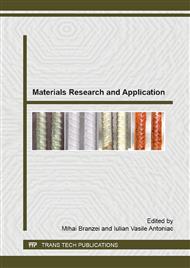p.219
p.224
p.229
p.233
p.239
p.247
p.253
p.258
p.266
Development, Microstructure and Corrosion Resistance of Al-Mg-(Si) Binary and Ternary System Samples in 5.3% NaCl Solution for Applications with Environmental Impact
Abstract:
For ensuring fuel consumption and pollution reduction, the researches made in the past decades considerable efforts to replacing steel with aluminum alloys in manufacturing auto bodies, or in naval transportation, because the promising weight saving. The researches consisted in general corrosion (the gravimetric index and the corrosion rate, Vcorr) and tensile tests (Rm, Rp0.2 and A5) in correlation with microstructure analysis of heat treated Al-Mg-(Si) system samples alloy, in order to obtain the best corrosion resistance and high mechanical characteristics. The Al alloys in extrusion state were solution treated at 510 – 545oC for 10-60 minutes, quenched in water 30-50o C and artificial aging at 150, 180 and 210°C at different time of aging (1, respectively 3, 7 and 11 hours). After heat treatment the obtained alloys were corroded in solution of 53g NaCl + 1000 ml distilled water and boiled in these solutions for 8, 16 respectively 24 hours. The gravimetric index was determinate by mass loss measurements for all types of heat treatment conditions. After corrosion test, samples were prepared for optical microstructural analyzing and mechanical tested. We have compared the obtained results on Al-Mg and Al-Mg-Si alloys. Were established (i) the optimum heat conditions parameters for obtaining of highest values of mechanical characteristics and corrosion resistance and also (ii) was explained the structural evolution during age (precipitation) hardening for both systems.
Info:
Periodical:
Pages:
239-244
Citation:
Online since:
July 2015
Keywords:
Price:
Сopyright:
© 2015 Trans Tech Publications Ltd. All Rights Reserved
Share:
Citation:


